- Laced Marijuana Hits Pine Ridge Streets
- New Details Emerge On Who Is Opposing Elk Grove Casino
- Northern Indiana Tribe To Break Ground On Tribal Village
- Veterans To Serve As ‘Human Shields’ For Dakota Pipeline Protesters
- Pokagon Band Says Casino, Village Project In South Bend Will Restore Its Sovereign Land
- 2 Malnourished Girls Found On South Dakota Reservation
A Letter from the Publisher

Shekóli. This past Sunday the water protectors near Standing Rock savored a victory when the Army Corps of Engineers announced that it would not grant the final permits for Energy Transfer Partners to drill under the Missouri River. “The Standing Rock Sioux Tribe and all of Indian country will be forever grateful to the Obama administration for this historic decision,” said Standing Rock Sioux Tribal Chairman Dave Archambault II. “In a system that has continuously been stacked against us from every angle, it took tremendous courage to take a new approach to our nation-to-nation relationship.”
Notes of caution were also struck, as outlined in this week’s lead feature, “Washington Blocks Pipeline.” Given the uncertainty swirling around the stance of the incoming presidential administration and the obstinacy of Energy Transfer Partners, it is difficult for anyone to make predictions. What is undeniable is how the actions of the past month have galvanized Indian country, raised critical awareness about its issues, and triggered an international conversation about the role big energy in a time of environmental stress. Native nations and peoples will continue to assert themselves because so much hangs in the balance.
Here at ICTMN, we will continue to remain vigilant. Over the past several months, we have committed critical resources to support our coverage. In multiple visits and lengthy stays at the camps and at Standing Rock, our team of editors and reporters has devoted hours of thought and energy to presenting this story in the right way. For those of us who had the honor of witnessing these events unfold, the experience will be something we will never forget.
But the job is not done. As we move forward, and while we celebrate this temporary victory, the fight is far from over. ICTMN will continue to focus on this struggle given that this temporary decision will be revisited in the coming months when the new administration takes office in Washington. We also must ensure that we do not brush under the table the injustices that have been committed at Standing Rock. They must be documented for historical purposes.
Given these commitments, it is a fitting time to mention some upcoming changes and enhancements at this media company. As part of the need to better serve our audience, and hold the attention of the growing number of people interested in Indian country, we will unveil new facets to our website in the days ahead and, with them, some exciting new developments and media products. This latest evolution will be in keeping with the level of innovation we feel is an obligation to our loyal and supportive audience.
This commitment is a recognition of the real source of influence in Indian country: you, the reader. We are grateful to all the active, informed people who have supported this outlet over the years, and who have placed their trust in the many fine correspondents and writers dedicated to sharing the Indian side of the story.
As always, the story continues.
NΛ ki wa,

Ray Halbritter
ICT News
Water Protectors Sue County And Authorities Over Pipeline Protests
By THERESA BRAINE
Protesters against the Dakota Access Pipeline are suing various parties for the alleged use of excessive police force in response to their demonstrations. The Water Protector Legal Collective filed suit against Morton County, North Dakota, Morton County Sheriff Kyle Kirchmeier and other law enforcement agencies in U.S. District Court on November 28.
The suit alleges “excessive force against peaceful water protectors” on November 20, when rubber bullets, mace, pepper spray and freezing water were deployed overnight during a standoff at a bridge on Highway 1806. Dozens of people were injured, among them 21-year-old Sophia Wilansky of New York City, who may lose her arm.
“The Morton County Sheriff’s office not only violates the constitutional rights of peaceful protesters, but their actions highlight the long history of abuse against Indigenous Peoples,” said legal collective lawyer Brandy Toelupe in a statement from the National Lawyers Guild. “From the beginning, governments have used their latest technologies to take land and resources from Native nations and oppress Indigenous Peoples. Sheriff Kirchmeier’s actions make it clear that nothing has changed.”
Filed on behalf of the injured, the class action suit “seeks an immediate injunction preventing the Morton County Sheriff’s Department and other law enforcement from using impact munitions such as rubber bullets and lead-filled ‘beanbags,’ water cannons and hoses, explosive teargas grenades and other chemical agents against protesters,” the Water Protector Legal Collective said in its statement. http://bit.ly/2gV63XE
Charges Filed In 2012 Arson Attacks On Ojibwe Religious Structures
By MARY ANNETTE PEMBER
The mystery behind a series of fires in 2012 targeting the practice of traditional Ojibwe religion on the Lac Courte Oreilles (LCO) Reservation in Wisconsin took a new turn with the filing of formal charges against an LCO member.
Christopher A. Grover, 42, was charged on November 18 with nine felony charges of arson and six felony charges of criminal fire damage in the July 14, 2012 fires. He is currently being held in the Sawyer County jail and is scheduled for a preliminary hearing on January 23.
The fires clearly targeted religious structures such as the historic Big Drum House, Big Drum Dance Ring, two sweat lodges and the business and home of Paul DeMain, a longtime journalist in LCO and follower of traditional spirituality. Set over the span of a few hours in the middle of the night, the fires set members of the reservation on edge.
In the criminal complaint, investigators noted that Grover’s stepfather, Jeff Crone, stated that Grover said he “believed that a member of the Lac Courte Oreilles tribe’s traditional religion, the Midewiwin belief system, had put a curse on the defendant [Grover] before the fires. Crone also testified that the defendant had shortly before the fires became a ‘born again’ Christian.”
A witness reported seeing Grover fill a gas can with gas at an LCO gas station and drive off without paying on the night of the fires. The complaint also described a July 15, 2012 meeting between Grover and law enforcement officials whereat the officials met Grover at the Crone home and noted that he had singed hair on his forearms. http://bit.ly/2fZv0zj
Arizona Governor And Tribes Sign Updated Gaming Compact
Arizona Gov. Doug Ducey and representatives of nine of 17 Arizona tribes renegotiated the state’s gaming compacts, originally created 15 years ago, in Phoenix on November 21.
“It’s time for us to modernize this compact to meet the changing needs of the state and to increase the opportunities for tribal gaming,” Gov. Ducey said. “The time has come to allow each tribe more freedom in their gaming operations and give every Nation the opportunity to have a seat at the table.”
Notably absent for the occasion was the Tohono O’odham Nation, which did not sign the compact. The tribe operates the West Valley Desert Diamond Casino in Glendale, for which the state denied a permit for Class III gaming last year because of its location. The dispute goes to U.S. District Court on December 14. But Judge David Campbell has requested that the parties notify him as to whether a settlement is possible.
“The Nation stands ready to consider compact amendment language that would resolve the outstanding litigation, including the Class III issue at its west valley facility, and includes language regarding no new casinos in the Phoenix area during the current compact,” a tribal statement read.
Gov. Ducey agreed to allow Class III gaming at the West Valley casino in exchange for a promise that the tribe will not seek additional gaming sites in the Phoenix area. The updated compact prohibits new casinos in the Phoenix area.
The tribes that signed the amended compact include the Gila River Indian Community, the Salt River Pima-Maricopa Indian Community, Fort McDowell, the Hualapai Tribe, the Tonto Apache Tribe, the Havasupai Tribe and the White Mountain Apache Tribe, reported the Glendale Star. http://bit.ly/2gJMuAG
ICT News
Chickasaw Nation Supports Search And Rescue Dog Training
By BRIAN DAFFRON
The Chickasaw Nation is collaborating on an effort to train search and rescue (SAR) dogs in Oklahoma to meet the needs of first responders in cases of natural disaster and man-made catastrophes. The initiative was unveiled on November 3 at the Oklahoma City National Memorial, the site of the 1995 Murrah Federal Building bombing that killed 168 people.
There are currently 11 trained SAR dogs in Oklahoma. But in a state where spring tornadoes and layered sheets of sleet in winter can destroy homes and bury families in rubble, authorities feel that at least 36 SAR dogs are required to meet the needs of first responders.
The new initiative, called “Ground Zero K9,” will train the dogs at a projected $20 million facility in the town of Tuttle that will comprise 120 acres. “We believe this project presents a significant opportunity to centrally locate search and rescue operations within this region,” said Chickasaw Nation Secretary of Commerce Bill Lance.”
The Chickasaws’ partners are former University of Oklahoma and Dallas Cowboys coach Barry Switzer and his wife, Becky. The nation’s partnership with the couple, said Lance, is an extension of a “long-standing relationship.”
“Our current funds will cover ten certified search and rescue dogs,” Becky Switzer told ICTMN. “We will continue our efforts to raise capital so as not to interrupt the pipeline we have in place.” The current focus of the training will be centered specifically on the search and rescue of living “finds,” she said, and that training to find human remains “will come once we have the search and rescue [facility] up and running.” http://bit.ly/2gIdLRM
$50 Million In Tax Credits Will Help Indian Country Development Projects
The Treasury Department has allotted $50 million in New Markets Tax Credit (NMTC) to Travois New Markets, a financial institution that assists Indian country development projects. The allotment was part of $7 billion in tax credit awards that the department released in November.
Based in Kansas City, Missouri, Travois New Markets is part of a family of companies that raises private investor capital for housing and economic development projects benefiting American Indian, Alaska Native and Native Hawaiian communities. Since its formation in 1995, this Community Development Entity (CDE) has helped bring over $1 billion of investment to Indian country.
Travois New Markets will use its allocation to help fund economic development projects sponsored by tribal nonprofits or governments, Native-owned for-profit businesses, and individual Native entrepreneurs in American Indian, Alaska Native and Native Hawaiian communities. It will focus investment in rural areas in all 50 states.
Travois New Markets has previously received awards totaling $180 million. With these allocations, it has brought investor equity to a wide range of projects that had faced financing gaps. These include Educare Winnebago, a comprehensive early education facility for the Winnebago Tribe of Nebraska; a fish processing plant in the Alaska Native village of Platinum; and a health and wellness center developed by Little Big Horn College, a tribal institution in Montana.
New Markets Tax Credits are allocated by the Community Development Financial Institutions Fund, a division of the Treasury Department, to qualified Community Development Entities. http://bit.ly/2gBcBdk
Native American and Hawaiian Mortgages Are Refused Half The Time
By MARK FOGARTY
Neither American Indians nor Native Hawaiians received half of the mortgages they applied for in 2015, according to data that lenders filed with the federal government. These figures include those who identified themselves as Native by race and Hispanic by ethnicity.
Native Americans (including Alaska Natives) received 46 percent of the loans for which they applied; Native Hawaiians (including Indigenous Pacific Islanders from Guam and American Samoa) had a success rate of 49.95 percent. Native Americans applied for 70,000 mortgages in 2015 and received 32,500, while Native Hawaiians applied for 49,000 and received 24,600.
In terms of dollar amounts, Native Hawaiians received 53 percent, or $6.4 billion, of the $12.1 billion they were seeking. Native Americans also inched over 50 percent in dollars requested, receiving $6 billion of $11.96 billion requested, or 50.8 percent. Thus, total Indigenous lending for 2015 came to $12.5 billion, up from $9.7 billion for 2014.
Native Hawaiians received $400 million more mortgage money than did Native Americans, despite constituting a smaller amount of the population. They also averaged more per loans, obtaining $277,000 on a first lien and $43,000 on second liens, compared to $201,000 on first liens and $42,000 on second liens for Native Americans. Moreover, Hawaiians received more “jumbo” (higher amount) loans than American Indians last year, by 25 to 16 percent.
The data is drawn from Home Mortgage Disclosure Act (HMDA) reports that were filed by some 7,000 lenders with the Federal Financial Institutions Examinations Council, an agency of the Federal Reserve, and other federal agencies. http://bit.ly/2gDPlYK
Washington Blocks Pipeline
‘Indian country will be forever grateful’
By JENNI MONETBottom Line: The federal government’s refusal to allow progress on the Dakota Access pipeline as currently constituted is a major environmental victory with an uncertain ending.

Fireworks fill the night sky above Oceti Sakowin Camp as activists celebrate after learning an easement had been denied for the Dakota Access Pipeline near the edge of the Standing Rock Sioux Reservation on December 4, outside Cannon Ball, North Dakota.
Scott Olson/Getty Images
Following months of standoff and periodic clashes between law enforcement authorities and thousands of activists, the federal government announced this weekend that it would not approve current permits for construction of the Dakota Access oil pipeline.
Army Department officials made the announcement on December 4. The decision halts building on the $3.8 billion dollar project, which has been partially stalled at the easement of the contested Missouri River, the primary water source for the Standing Rock Sioux Tribe.
But even as pipeline opponents celebrated, they were faced with eviction from their encampments—concentrated at Cannon Ball, North Dakota—by order of the Army Corps of Engineers and North Dakota Gov. Jack Dalrymple. The former authority had given the water protectors a deadline of December 5 to leave.
The Army’s Assistant Secretary for Civil Works, Jo-Ellen Darcy, said the decision to deny permits that would have allowed was based on a need to explore alternate routes for the 1,172-mile-long pipeline. Plans called for burying the pipeline approximately 100 feet below the Missouri River.
“Although we have had continuing discussion and exchanges of new information with the Standing Rock Sioux and Dakota Access, it’s clear that there’s more work to do,” she said.
The federal agency is now recommending that an Environmental Impact Statement be conducted with full public input and analysis to explore a possible reroute of the pipeline.
The Standing Rock Sioux Tribe has long argued that the existing path of the energy project threatens the Missouri River and sacred sites. President Obama blocked construction of easements on both sides of the river in early September; last month, he publicly stated that the Army Corps of Engineers was considering alternate routes for the pipeline project.
“The Standing Rock Sioux Tribe and all of Indian country will be forever grateful to the Obama administration for this historic decision,” said Standing Rock Sioux Tribal Chairman Dave Archambault II. “In a system that has continuously been stacked against us from every angle, it took tremendous courage to take a new approach to our nation-to-nation relationship.”
However, Energy Transfer Partners, which operates the pipeline, has publicly rejected the idea of a reroute. Consequently, tribal leaders and organizers hinted that their fight might not be over.
“We hope that [Energy Transfer Partners CEO] Kelcy Warren, Governor Dalrymple and the incoming Trump administration respect this decision and understand the complex process that led us to this point,” said Archambault.
“Our network is singing the victory song with the Standing Rock Sioux,” said Tom Goldtooth, director of the Indigenous Environmental Network. “We are cautiously hopeful that this is a total win.”
At press time, two separate orders from the Army Corps and Gov. Dalrymple to evacuate the Cannon Ball protest camps were pending. The Corps’ directive was issued on November 25; three days later, Dalrymple ordered the immediate and “mandatory evacuation of all persons located in areas under the proprietary jurisdiction of the United States Army Corps of Engineers located in Morton County.”
The two directives were issued within days of Morton County Sheriff’s deputies spraying rubber bullets, mace and water in subfreezing temperatures on more than 400 people demonstrating at a bridge blockade not far from the protest camps. Both directives emphasized the importance of public safety.
“Pursuant to C.F.R. 327.12, I am closing the portion of Corps-managed federal property north of the Cannon Ball River to all public use and access,” wrote the Corps’ Omaha District Commander, Col. John W. Henderson. “I do not take this action lightly but have decided that it is required due to the concern for public safety.”
“The Army Corps of Engineers is seeking a peaceful and orderly transition to a safer location, and has no plans for forcible removal,” Henderson wrote. “But those who choose to stay do so at their own risk as emergency, fire, medical, and law enforcement response cannot be adequately provided in these areas. Those who remain will be considered unauthorized and may be subject to citation under federal, state, or local laws.”
Henderson added that his agency “has established a free speech zone on land south of the Cannon Ball River for anyone wishing to peaceably protest.”
In his executive order, Dalrymple invoked his authority to “minimize or avert the effects of a disaster or emergency” and cited the Army Corps eviction order. Pointing to the potential hazards of the upcoming winter, he said that at the camps, “large populations” were congregated “in tents, vehicles, temporary and semi-permanent structures which have not been inspected and approved by Morton County as proper dwellings suitable for winter habitation.”
Prior to the pipeline being halted, and as the December 5 eviction deadline loomed, many water protectors registered defiance.
“They may have to bring the Army to get rid of us,” said Toni Cervantes, 65, of San Francisco. “There will be a worldwide uproar if this is done as violently by the militarized police as it has been. I can’t even imagine. I’m just praying for a peaceful end to this whole thing.” http://bit.ly/2gqYPXA, http://bit.ly/2gBaYc4 and http://bit.ly/2gV63XE
Additional reporting by Theresa Braine.
Traditional Growth
‘We’re exposing our products to the non-Indian world’
By LEE ALLENBottom Line: A certain hardy bean, grown on a certain farm in Arizona, illuminates a certain way of Native life.
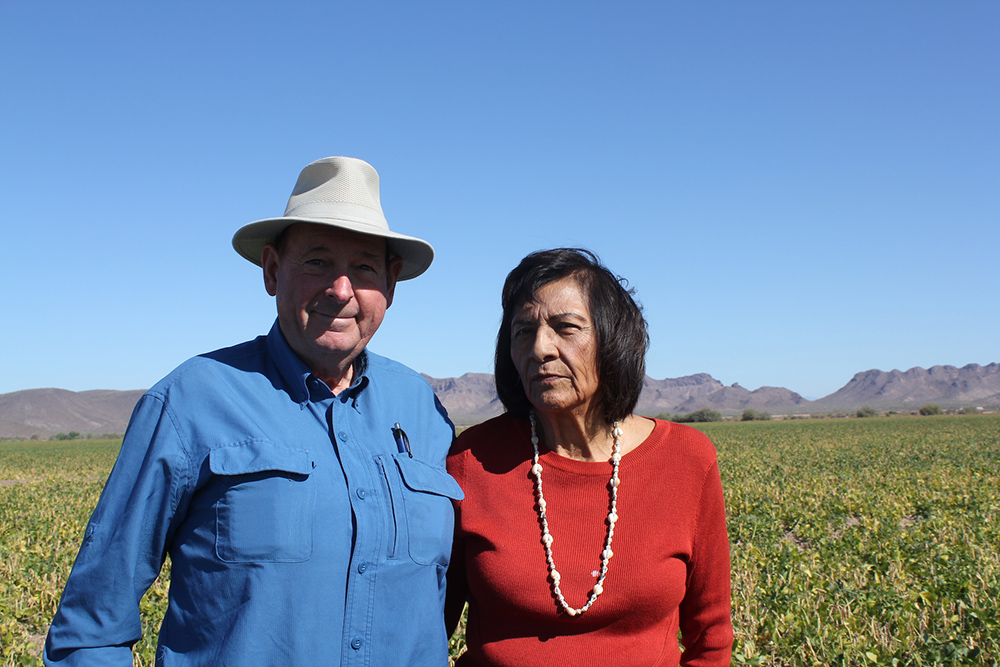
The bavi bean field of Terry and Ramona Button is as much a testament to culture as it is a business.
Lee Allen
At their Gila River reservation farm in Sacaton, Arizona, the husband-and-wife team of Ramona (Pima by birth) and Terry (Lakota through adoption) Button cultivate thousands of acres of rough desert terrain. Here, at the foot of the San Tan Mountains, they till and tell of traditional times.
Ramona has been sowing seeds since she was a little girl helping her father transform the desert landscape into the family’s first 10-acre plot—half to raise forage for the animals, the other half for a sustenance garden.
“My father, Francisco ‘Chiigo’ Smith, was a carpenter, a blacksmith, an adobe block-maker, an herbalist, and a traditional healer,” she said. “You had to teach yourself how to do everything because we were self-reliant. He grew Pima wheat, corn, chiles, melons, squash, and tepary beans.”
It is that last crop that links the Buttons’ agricultural past, present and future.
Ramona grew up on her namesake farm working the fields and living in a two-room earthen floor adobe home built by her father. She and her husband began planting her parents’ allotment in the mid-1970s; they continued to expand their acreage, doubling and then quadrupling it.
Early on, before the advent of today’s equipment availability and weed-resistant crops, Ramona had to leave her job as a nurse at Sacaton Indian Hospital to run the hoeing and weeding crew. She supervised a crew of 15 community members and did so for 15 years until machines replaced human hands. The family-run endeavor began to grow in scope. And then community elders began asking the Buttons if they would grow tepary beans, also known as bavi.
Bavi are among the most drought- and heat-tolerant crops in the world; they are even found in Mexican deserts where annual rainfall is just three inches and temperatures hover near 120 degrees. They come in several varieties: black (S-chuuk), an earthy-tasting brown (S-oam) and a sweet white (S-totoah). They are high in protein, low on the glycemic index and contain soluble fiber helpful in controlling both diabetes and cholesterol.
When the community elders approached the Buttons about growing bavi, however, the beans were all but extinct. Fortunately, they had been handed down for generations amongst the Akimel O’odham (River People, Pima) and their Tohono O’odham (Desert People) cousins. Ramona’s father had the foresight to save some beans in a jar. These became the seed crop that helped save the world’s most drought-adapted bean species from disappearance.
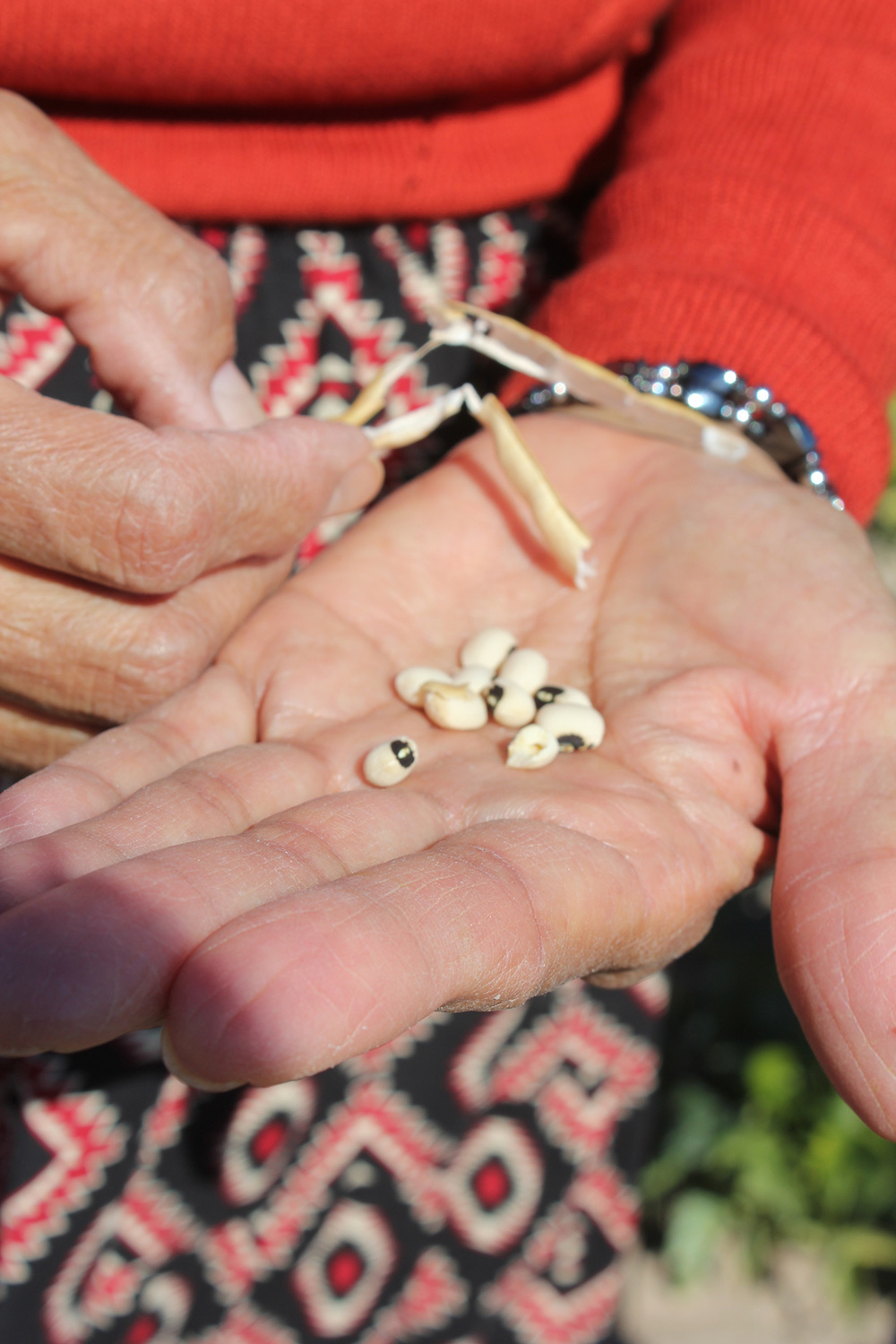
Bavi are among the world’s most drought- and heat-resistant crops. Lee Allen
Bringing back the bavi allowed the Buttons to focus on traditional crops. “We keep a foot in both worlds,” Terry said. “We’ve dedicated ourselves to preserving crops of the Pima people and encouraging a return to a traditional diet. But in order to stay afloat economically, we utilize current cultivation technology. So we farm in a 21st century way, but still rely on traditional concepts.”
With anywhere between 4,000 and 7,000 acres under cultivation at any given time, the Buttons grow a variety of items that pay tribute to the area’s long Native heritage. Their fields range from more than 50 acres devoted exclusively to three types of tepary beans, along with garbanzo beans, black-eyed peas, and four varieties of corn that represent Pima, Hopi, and Supai tribes. There is also barley, hay, alfalfa, cotton, and three kinds of wheat.
“Pima people represent the dawning of Arizona agriculture and their practices were adopted by settlers who arrived later,” Terry said. To which Ramona added, “Life here on our 500-square-mile reservation is still very traditional in many ways, slower-paced than communities off-reservation.”
And although Ramona Farms offers wheat berries, wheat flours (pilkan chu’i) and corn products (huun) along with the other offerings, the family’s production centerpiece is the tepary (phaseolus acutifolius), native to Mexico and the western U.S. and grown there since pre-Columbian times.
Today, the family operates on the “share what you know” concept, knowing that their products provide nutritional benefits without artificial ingredients and wanting to pass that information along. “Our label says ‘Bring Our Traditions to Your Table,’” said Ramona. “We’re exposing our products to the non-Indian world and they’re being well received. More people are becoming health conscious, making wiser food choices, and looking for less processing and additives, which fits right in with what we’re doing.”
(A footnote: Earlier this year, Ramona Farms was honored with the Good Food Good Person Award in the annual Arizona Farmer+Chef presentations. The Buttons were acknowledged as farmers who “grow, raise, and make tasty, nourishing, healthy-for-the-mind-and-body foods, and see food as a way to create community.”) http://bit.ly/2gDoXBC
Remembering Sand Creek
‘They destroyed the home, but not the foundation’
By KONNIE LEMAYBottom Line: In Denver, a memorial to a Native massacre of more than 150 years ago is achieving poignant shape.
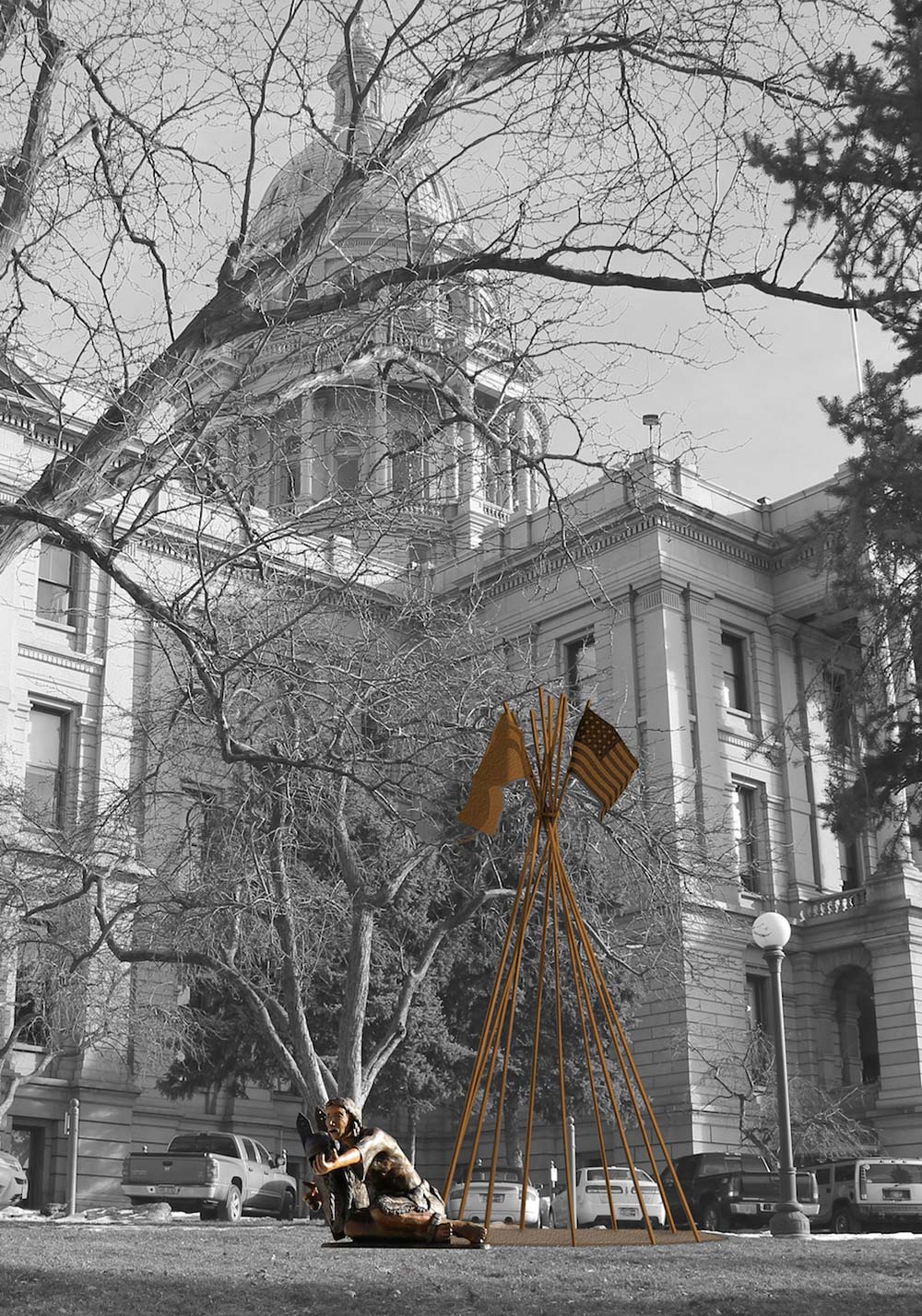
The proposed Sand Creek memorial is seen here in a computer rendering as it would be situated on Capitol grounds.
Courtesy Earth One Future
“Remember us. Don’t forget us, remember us.”
These words, passed down from survivors of the Sand Creek Massacre of 1864, have informed a proposed memorial to the slaughter in Denver, Colorado, to be situated across the street from the Capitol building.
The project, conceived in 2014—the 150th anniversary of the murders—is coming ever closer to realization.
To date, $162,800 has been raised toward the goal of $194,000 for the “Remember Sand Creek” initiative. Since February 2015, the effort has been shepherded through the state legislature for approval and fundraising aid by One Earth Future. The organization is dedicated to achieving sustainable peace through building effective networks and resilient societies in fragile and post-conflict environments.
“The State Capitol Advisory Committee unanimously approved the proposed plan to site the memorial on state Capitol grounds,” said One Earth Future Senior Manager of Public Relations Debra Havins. The next step will be to bring the proposal before the full legislature in 2017.
Gov. John Wright Hickenlooper Jr. has supported the memorial, as have many Cheyenne and Arapaho elders. Forensic artist Harvey Pratt (Cheyenne/Arapaho) was commissioned for the design. He likes having something on the Capitol grounds to keep the memory of the people alive and to help Coloradans know their history.
“I think it’s important that the truth is told about our history—the history of America,” he said. “So many things have been hidden—violence, deception and deceit. All of those things have to be told.”
Pratt was born in Oklahoma. For him—as for so many in the diaspora of Cheyenne and Arapaho people—remembering what happened on November 29, 1864 is personal and not as distant as the hundreds of miles or 152 years might seem.
Some of Pratt’s ancestors survived that unprovoked attack, whereat 675 cavalrymen descended to Sand Creek on the peaceful village of about 700 Cheyenne and Arapaho people. But others did not survive. At the end of the bloody rampage, as many as 200 Native people—mainly women, children and elderly—lay dead and an equal number wounded.
“My great-grandfather and great-grandmother were both survivors,” Pratt said. His great-grandmother was Julia Bent, who was half-white and half-Cheyenne. Her non-Native father built Bent’s Fort along the Santa Fe Trail. After the massacre they, like so many others, were moved out of their home territory. Pratt’s family was dislocated to Oklahoma; others were moved there and elsewhere. The Northern Cheyenne in Montana, the Cheyenne & Arapaho Tribes in Oklahoma, and the Northern Arapaho in Wyoming have roots in Colorado and ties to the Sand Creek tragedy.
Anxiety from the massacre, along with forced moves, rippled through history into Pratt’s generation. “Growing up,” he said, “my mother’s aunt, who lived with us, would say, ‘When you go to bed, put your shoes right by your bed because you might have to get up and run.’” The elders, he added, ”told little stories about that—who was injured … who didn’t make it.” In those stories, the children were told of the dying calling out, “Remember us. Don’t forget us, remember us.”
All of that Pratt kept in mind in designing the proposed memorial. His artwork centers on a fallen woman holding an empty cradleboard and reaching outward. She bears the wounds traditional to the Cheyenne people in mourning. The full memorial will also include a representation of a tipi without hides—just the poles “to show that they destroyed the home, but not the foundation.”
There will be a U.S. flag and a white flag, both flown over the village at Sand Creek, as the people were told to do to show they were not at war with the United States. The attacking soldiers ignored that gesture. So horrifying was the massacre that even then the U.S. Congress condemned it, thanks to some soldiers who came forward like Silas Soule, later murdered on the streets of Denver—presumably in revenge for his opposition.
Pratt has another vision to tie the past with the present and future. “On a pathway that we’re going to pour in concrete, six feet wide and 20 yards long, we’ll have descendants put their footprints in it—children and adults. It will show some running away from the battle and represent that we’re still here.”
Pratt feels a memorial at the Capitol will bring more attention to the past. Eerily, the proposed project will be situated across from the statue of a Union soldier appearing triumphant from the Sand Creek attack. The statue drew the shocked attention of John B. Judis, who wrote about it in The New Republic on the occasion of the 150th anniversary of the massacre.
“There is now an additional plaque there that corrects the history,” Debra Havins said. Perhaps the proposed Sand Creek Massacre memorial will tell an even more complete and honest story.
“We are just going to bring history to life,” Pratt said. “We just want people to understand that there was more to what happened than what was told.” http://bit.ly/2gWwfkt
Bois Forte Tribal Government
Housing Department
ADVERTISEMENT –
REQUEST FOR PROPOSALS
The Bois Forte Housing Department in Nett Lake, MN, is soliciting Proposals to study the needs of our maintenance program and to provide policy updates to improve the timeliness, cost and quality in the delivery of our services.
All proposals are due by December 23, 2016 by 4:00 P.M.
Inquiries concerning this RFP should be mailed to:
Dani Pieratos, Office Manager
Bois Forte Housing Department
5344 Lakeshore Drive
Nett Lake, MN 55772
P: (218) 757-3253
F: (218) 757-3254
Or e-mailed to:
dpieratos@boisforte-nsn.gov
This invitation is unrestricted; however, preference shall be given to Indian Organizations and Indian Owned Economic Enterprises in accordance with 24 CFR 1000.48, 1000.50 and 1000.52.
The Week in Photos

Paul Natkin/Getty Images
Rock icon Neil Young called on President Obama to “end the violence against the peaceful water protectors at Standing Rock immediately.”

YouTube/WatchCut Video
The model Sage Honga is demonstrating 100 years of Navajo/Diné fashion sense as part of a series by “WatchCut Video” on YouTube.
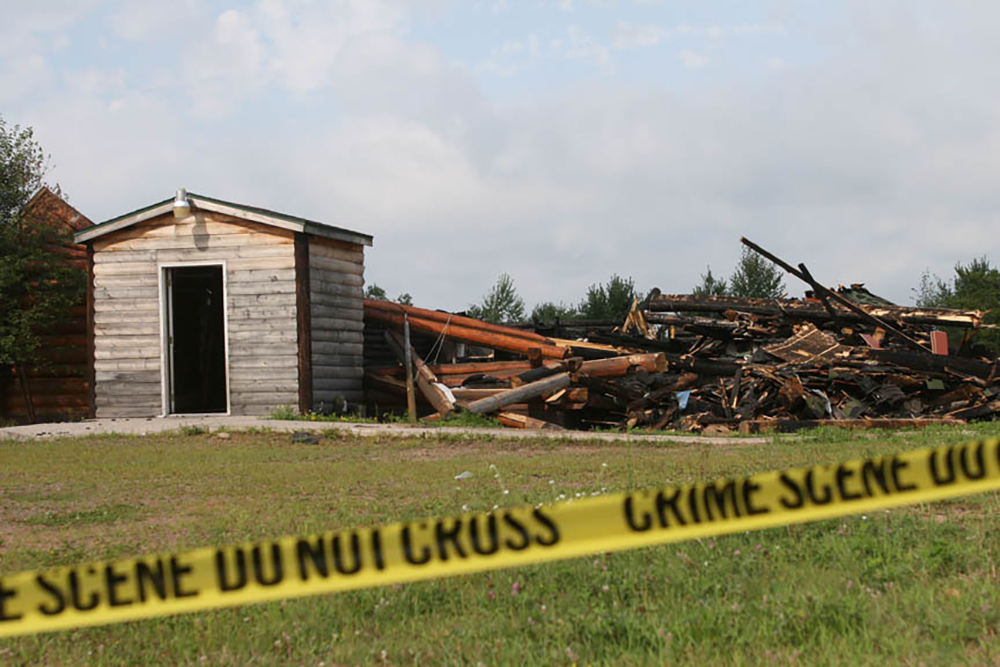
Mary Annette Pember
Charges have been filed in the 2012 case of several fires that targeted religious structures on the Lac Courte Oreilles Reservation in Wisconsin.
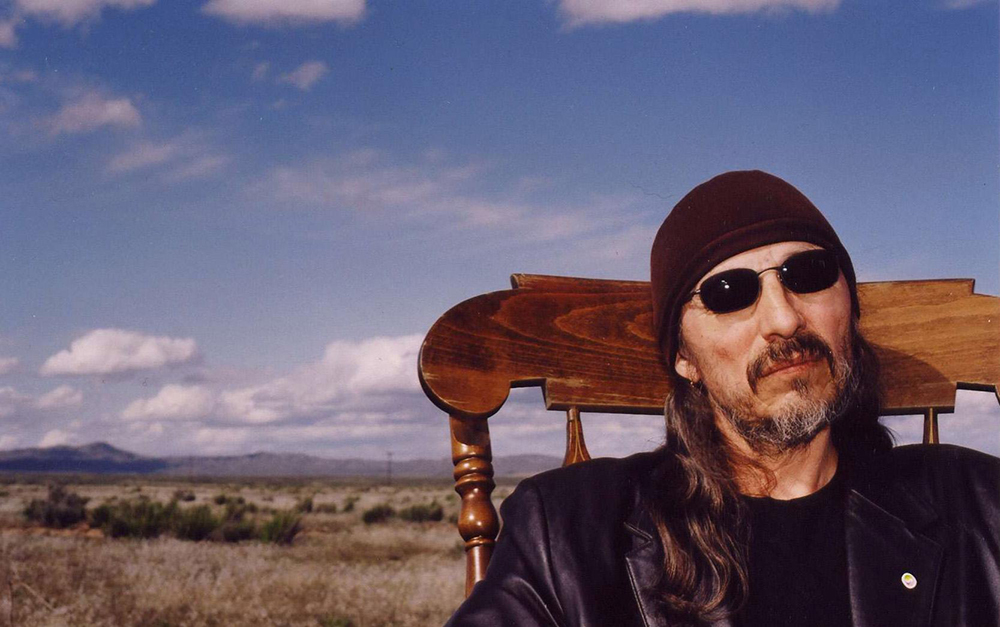
Vision Maker Media
Trudell, by producer/director Heather Rae (Cherokee), is one of four free-streaming films this month as part of Vision Maker Media's 40th anniversary.
Headlines from the Web
Upcoming Events
December 8-10: Native American Grant School Association Winter Conference
“Joining Hands to Empower Student Achievement” will offer a series of workshops in furtherance of NAGSA’s goal of serving the unique needs of grant schools created for Indian country by the Tribally Controlled Schools Act of 1988.
Location: Gold Coast Hotel & Casino, Las Vegas, Nevada
December 8-10: Justice for Victims of Crime
The 15th National Indian Nations Conference will explore the theme of “Harnessing Our Collective Wisdom: Strengthening the Circle of Safety, Justice and Healing.” The goals include honoring and listening to victim/survivor voices; promoting safety, justice and healing; honoring the wisdom of the past; promoting traditional values; working in harmony; and supporting and educating tribal leaders. The event is coordinated by the Tribal Law and Policy Institute, under a grant from the Office of Victims of Crimes (OVC), Office of Justice Programs, within the U.S. Department of Justice.
Location: Agua Caliente Reservation, California
December 12-14: International Aboriginal Tourism Conference
The Aboriginal Tourism Association of Canada will host this year’s conference, devoted to improving the socioeconomic situation of Aboriginal people through the provisions of economic development advisory services, conferences, professional and development training, and workshops, industry statistics and information for Aboriginal tourism operators and communities. Keynote speakers include Minister of Indigenous and Northern Affairs Carolyn Bennett, World Indigenous Tourism Association Chair Ben Sherman, and Destination Canada President and CEO David Goldstein.
Location: Membertou, Sydney, Nova Scotia
December 13-14: IHBG and ICDBG Implementation Training
This training is offered by the Department of Housing and Urban Development’s Office of Native American Programs as a primer on the Uniform Administrative Requirements, Cost Principles, and Audit Requirements for Federal Awards, a.k.a. the Office of Management and Budget’s new “Uniform Guidance Final Rule.” To support tribes and Tribally Designated Housing Entities during the implementation stage, the training will emphasize the practical application of the Uniform Guidance and provide resources and tools that recipients can utilize to identify changes that recipients must make to their administrative and/or management systems.
Location: NPONAP Training Room, Denver, Colorado
Letters to the Editor
Terese Mailhot’s urging that white people be braver in standing up for Native issues, most recently at Standing Rock (Nov. 18), is an accurate capture of current trends and the path forward.
As a white male growing up near the rez, I have found that there were plenty of “cringe” moments while crossing the racial barrier. The most discomfort I have felt was not when being made fun of (that actually creates belonging), or when I say the wrong things and ten disgusted faces turn at once. Instead, the most discomfort is when the “overly eager Christian” women show up with casserole and Bibles.
My race has no mechanism for properly raising strong female leaders and elders. It is a void I feel when I reflect on the feeling of community that Natives have and that whites do not. It feels good when I see the elders receiving respect. Being surrounded by authenticity is a relief. That is sorely missing in my race.
—David Odell
Scottsville, New York

Top News Alerts
UPSET IN OGLALA LAKOTA ELECTION
By a surprising margin, challenger Scott Weston defeated incumbent John Yellow Bird Steele in last month’s election for chairman of the Oglala Lakota Tribe. The final tally of 2,721 votes to 1,414 was formally announced on November 29, three weeks after the election took place. “My number one initiative is to listen to the people,” said Weston. “They want to be heard, they want economic development, they want change. The point I’ve made in the past is our constitution needs revision.”
NEIL YOUNG ISSUES STANDING ROCK STATEMENT
The rock star Neil Young has issued an open call to “end the violence against the peaceful water protectors at Standing Rock immediately.” On his Facebook page Young joined with his girlfriend, the actress Daryl Hannah, to urge President Obama to personally intercede in the matter and concluded, “The progress we have made over two hundred and forty years as a nation has always come first from the people.”
TULALIP MEMBER LEADS WASHINGTON DEMOCRATIC CAUCUS
John McCoy (Tulalip Tribes) was elected chairman of the Washington State Senate Democratic caucus on November 15. He served in the House from 2003-2013, when he was appointed to a Senate vacancy and was elected to a full term the following year; he was formerly general manager of Quil Ceda Village, an incorporated community on the Tulalip reservation. McCoy is one of three Native Americans in the legislature; the others are Democrat Rep. Jeff Morris (Tsimshian) and Republican Rep. Jay Rodne (Bad River Band of Chippewa).
OPPORTUNITIES FOR NATIVE STORYTELLERS
Two major arts programs are offering opportunities for writers of Native narratives: the Yale Indigenous Performing Arts Program’s 2nd Annual Yale Young Native Story Tellers Conference and the Oklahoma City Theatre Company’s 8th annual Native American New Play Festival. YIPAP focuses on “storytelling by Indigenous youth to support the new generation of storytellers,” while the OKCT showcases “stories for the stage authored by Native American, First Nations, Alaska Natives, Hawaiian Natives, and Indigenous Mexico.” The application deadline is December 31 for the former competition and February 17 for the latter.
SEMINOLES SELL STAKE IN CITRUS OPERATION
The Seminole Tribe has sold its share of ownership in Blue Lake Citrus to Sun Orchard, a major Miami-based juice and beverage products producer. The Seminoles made the sale with their partner William G. Roe & Sons Inc.; the Roe family founded Blue Lake Citrus in 1927 and the Seminoles acquired a 60 percent stake in April 2014. Sun Orchard, founded in 1984, is owned by the New York-based private equity firm Centre Partners.
How Did I Miss That?
Goings on up north, the star-spangled Queen of Soul and the better side of Catherine Zeta-Jones
BY STEVE RUSSELL
The BBC reported the response of Catherine Zeta-Jones, 47, to the intrusion of paparazzi into her Mexican vacation with her husband of 16 years Michael Douglas, 72. Angered by the publication of unflattering bikini photos, Zeta-Jones took to Instagram to say she was “sharing the photographs my husband took of my ass.”
Two conclusions from the photos she shared were that she is aging well and that she had just rendered the pirated photos worthless.
* * *
There was another case of a woman taking charge and doing it her way last month. The occasion was the Thanksgiving Day game between the Detroit Lions and the Minnesota Vikings, whereat the Queen of Soul, Aretha Franklin, sang the national anthem. I don’t like “The Star-Spangled Banner” because it is not singable by ordinary people. But once in a while, somebody with Franklin’s range and power will get hold of that song and whip it into shape. She took over four minutes, and it was worth every second.
Have I changed my mind about the song? No, because you and I are not Aretha Franklin. But she made it as entertaining as it’s ever been.
“Whoa,” my Cousin Ray Sixkiller interrupted.
* * *
Reminded of the Jimi Hendrix version of the anthem at Woodstock, it occurred to me that Donald Trump’s white nationalist fans would not be happy that two non-white artists nailed the song. Then a third version by a non-white artist came to mind and I realized that the white nationalists would object to this one for a whole other reason: They think the national anthem can only be sung in English. Wrong.
* * *
Sputnik reported that the so-called Islamic State—known as Daesh among Arabs who don’t like it—has further diversified its economy by entering the black market for human organs. Last year, a Daesh-friendly cleric issued a fatwa that allowed organs to be removed from healthy captives to save the life of a Muslim. Some organs are reportedly taken from their own fighters, but only when they are dead. I would find this hard to believe had Daesh not done worse on video.
* * *
While I have nothing but good things to say about every time I’ve visited our Canadian friends, I can’t claim to always understand them. Sometimes, I can only report.
For instance, the BBC noted that on their Facebook page the Kensington Police Service—the guardians of Prince Edward Island—were threatening an innovative punishment for drunk drivers. They warned that the police cruiser would play the Canadian rock band Nickelback on the way to jail.
The Facebook responses showed there was no failure to communicate in Canada, with one reader asking, “Doesn’t torture go against the Geneva Convention?” Another reader, apparently a Nickelback fan, suggested replacing the band in the drunk driving torture with Justin Bieber.
* * *
My puzzlement continued with another BBC report from the Canadian Parliament, where Conservative MP Michelle Rempei accused the government of treating Alberta “like a fart in the room.” This drew the ire of Green MP Elizabeth May for using the word “fart,” which May claimed was “distinctly unparliamentary.”
* * *
Maybe Canada should follow Wales and consider making an advisory list of “unparliamentary” words. The Welsh list contains words that register in the U.K. but not here, like “bleeding obvious” and “bollocks,” as well as such familiar terms as “corrupt,” “cowardly,” “deceit,” “deliberately misled,” “dishonest,” “dubious,” “evasive,” “hypocrisy,” “liar,” “mealy mouthed,” “misleading,” “misrepresented” and “sneaky.”
“How do you talk about politics,” Cousin Ray wanted to know, “without those words?”
* * *
KVUE reported that state workers at a new office building in Austin, Texas have been alarmed by the number of snakes showing up recently. In the last 16 years, only two persons have died from rattlesnake bites in the entire state.
Cousin Ray reminded me that Texas turned down Obamacare funds to expand Medicaid and has the highest percentage of people with no health insurance among the states. He asked if I wanted to bet that the two-legged snakes in state government killed fewer people than rattlesnakes. http://bit.ly/2gjcAav
The Big Picture


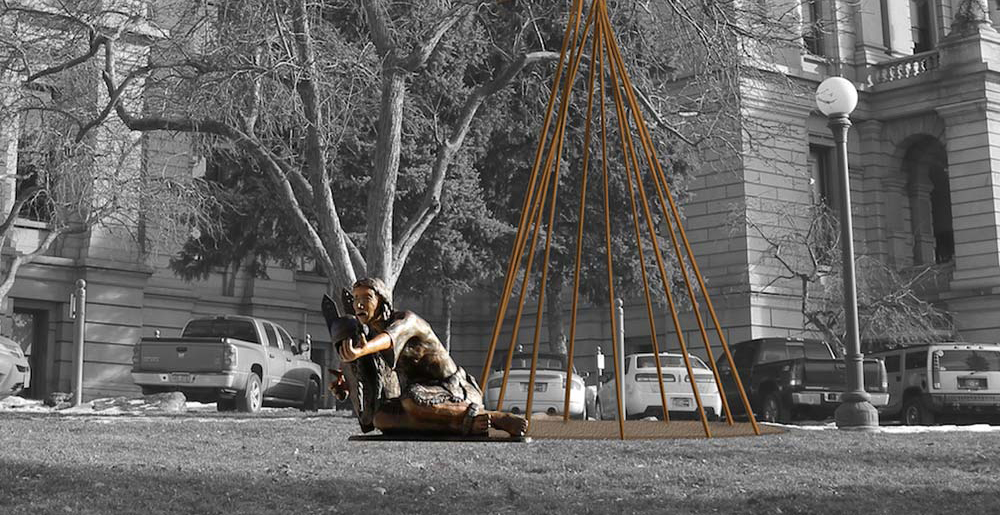


Commentary
When Tears Are Sweet And Sour
Natives who are feeling schadenfreude over white liberals’ reaction to this election should think twice, writes Terese Mailhot:
White people on the left are coping with the realization that America is racist. Aren’t we all tempted—when we see white people in tears over their disenfranchisement—to say, “Now you know”? I wonder what our tears tasted like all these years.
It’s small of me to feel that way. Eventually these white people will learn to laugh at the absurdity and get to their cars safely, and stay on the right side of the street, or know when to walk straight ahead without averting their eyes, or how to comply, or how to distrust authorities, doctors and institutions. I’ve been doing that Indian thing where I disassociate and make jokes until I can commit to life again or resign completely.
Donald Trump is the president-elect. It’s horrible. But my people have had worse chiefs and council members. They disenfranchised their own people and kicked elders out of homes and betrayed their own families. We lived through that and felt worse for it, but we lived. And I know we lost our familiarity with our own languages and cultural affinities, but I don’t feel I’m less of an Indian woman because I’m dispossessed. The elders in my life have told me, with a smile, that had the white man never come, we would still have an ever-changing and adaptive culture.
Enjoying white tears is poison. Personal vengeance isn’t good for the heart. We need our allies, so I’ve taken to letting them in. I retain my humor and my distance. But when white people cry, I tell them I’m here. When I break down, I hope they’ll be there for me. http://bit.ly/2gPDYRi
The Pain And Power Of The Braid
When First Nations boys are teased about their braided hair, writes Carly McIntosh, they need spiritual and cultural aid:
The long braid of a First Nation’s male symbolizes many things: strength, wisdom, identity and culture. Many First Nations people believe that getting their hair braided right before a powwow or a ceremony brings in positive energy and strength passed down to them from their elders and ancestors.
But in Thunderchild First Nation—today known as Saskatchewan—many young boys get bullied for letting their hair grow long and then formed into braids. After a youth is continually teased and harassed in school for a while, he succumbs to the pressure and slices it off.
Recently Michael Linklater, a Thunderchild First Nation father, saw that his two sons were being bullied for their hair. After he heard that other young boys were also being teased, he organized a campaign called “Boys with Braids.” Having once been disrespected in school for his braid himself, Linklater now is not afraid to stand up for his cultural beliefs and give strength to the young who need it. His campaign has been taken to two Canadian cities; many others will see it in the future.
Each day a young boy gets bullied or teased over his braid, one of us needs to stand by our younger brother and support him and not leave until it has stopped. First Nations are meant to hold each other’s hands, and our nations will never give up on each other because together we are as strong as Mother Earth. When our young boys are bullied and teased about their braids, they need the protection of our spiritual family. http://bit.ly/2fXBYlS
Decolonization In The Mind And On The Tongue
The right patterns of thought and language can combat the wrong patterns of oppression, writes Steven Newcomb:
Colonization requires a tremendous amount of skillful mental activity. It therefore stands to reason that decolonization requires the same.
Because our Original Nations have been colonized, i.e. invaded, oppressed, and robbed, we must gain mastery over the invaders’ language system. We must then gain mastery over their system of ideas and argumentation. Then we have to devise our own unique set of counterarguments.
One barrier standing in the way of decolonization is the large number of our own people who have gained some mastery over the invaders’ language system and system of argumentation—and then made a “career” out of functioning within that system, rather than critiquing it. Unfortunately, a great many of us are not willing to engage in the amount of reading and difficult mental work necessary to break free of and challenge the American empire’s well designed construct of ideas and arguments.
Language constitutes and creates reality. So staying within the confines and limits of the colonizers’ system of ideas and arguments—particularly those of the U.S. federal Indian law system of domination—amounts to staying confined.
There is a strange, unstated belief by which many of our own people are subconsciously hindered. Some people have a sense that it’s “against the law” to challenge the domination system. But we ought to collectively convey that there is no such thing as a right of domination. The next four years will make it necessary for our Original Nations to consolidate our efforts and mobilize ourselves more effectively than ever before—as if our lives and our future generations depend on it. http://bit.ly/2gwqzwD